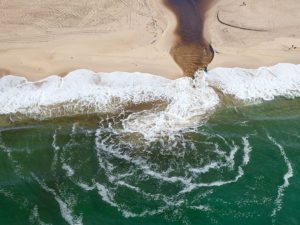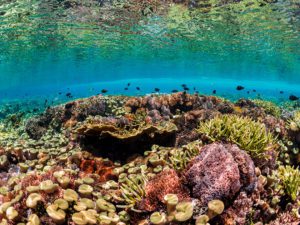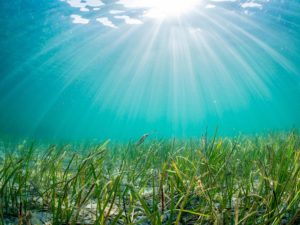Jump to:
NEW! Browse and filter actionable interventions for Pollution. Jump down the page to the Solutions Typology Table
Overview of the Solutions Landscape
Ocean pollution can come from both land and sea; this chapter focuses primarily on land-based sources of ocean and coastal pollution. Pollution—in the form of chemicals, pathogens, nutrients, and physical waste—comes from almost all human activities. It can come from cities that discharge directly into the ocean through sewer outflows, poorly designed landfills, and direct trash dumps or from stormwater runoff that washes pollutants into waterways and eventually into the ocean; from farms where rain and irrigation causes the pesticides, fertilizers, and plastic used to grow crops to run off or be disposed of unsafely; from the effluents, toxic chemicals, and physical wastes discharged from factories (into the water) and from fossil fuels and chemicals that are burned and spewed into the atmosphere, traveling long distances until they deposit in the ocean; and from ocean-based industries like aquaculture, shipping, oil and gas production, cruise travel and ferries. “The ocean is the ultimate sink for anthropogenic pollution,” said the High Level Panel for Ocean Sustainability in 2019.1
When thinking about solutions to ocean pollution, it is helpful to try to answer four key questions in sequence:
- What is the harm being caused?
- How is pollution causing harm? (e.g., from what source, and via what mechanism)
- Who is responsible?
- What can (or should) they do about it?
Identifying what pollutants are entering the ocean environment, and what harm they are causing, is the foundation of action to address ocean pollution. Basic research and monitoring is required to understand the impacts that land-based pollutants—whether that be sewage from our cities, plastic from trash, or fertilizers and pesticides from agriculture—are having on ocean and coastal ecosystems. Impacts can vary depending on ecosystem type (e.g., a salt marsh versus. the open ocean) and a whole host of biological, ecological, and human demography factors. For this reason, place-specific research is often required to understand the unique ways in which pollutants travel from source and ultimately where they are causing impacts to the environment and human life. While there is a strong base of research on the impacts of some pollutants and in some places (e.g., the impacts of excess fertilizer use on the Gulf of Mexico Dead Zone), some pollutants are not studied at all, and there is very little understanding of what is entering the ocean and what harm it is causing (including for microplastics and microfibers). This is where efforts like investments in oceanographic research, new sensing technologies, and citizen science efforts to collect water quality data can be critical.
Laws, policies, regulations, and standards—from local to national and international levels—set out the requirements to prevent, manage, or clean up ocean pollution. Most laws to protect water quality exist at the national level, which, depending on the governance framework, may be passed down to more distributed local government levels. Examples of these laws and frameworks include the Clean Water Act in the United States and the EU Water Framework Directives. According to UN Environment, water quality, waste management, nature and biodiversity, air quality, and noise are all major gaps in environmental law implementation globally—this in spite of the fact that 176 countries have environmental framework laws or other mechanisms to consider the environment in development.2 These laws are plagued by weak enforcement, unclear standards, no legal mandates, a lack of tailoring to local conditions, and implementing ministries that are under-funded or politically weak. In places where these frameworks are weak or poorly enforced, awareness raising activities such as campaigns for plastic bans or to fix persistent sewage leaks can help create the impetus for enforcement and funding. Voluntary standards, like many state-level Water Quality Standards in the US, are largely seen to be ineffective in driving improvements in pollution outcomes.3 Some international and regional standards and guidelines exist—such as the Cartagena Convention for the Caribbean and the World Health Organization’s Recreational Water Quality guidelines—but there is no global framework or treaty requiring states to manage land-based sources of ocean pollution, leaving a critical gap in management and enforcement.
Monitoring and enforcing these frameworks is a major area of government and civil society action. In places where water quality laws exist that apply to coastal and marine areas, ensuring appropriate monitoring of conditions, reporting of discharges, and enforcement in situations of non-compliance are a key focus of government and civil society. For example, in the US, water quality at beaches is monitored in a patchwork fashion by the BEACH Act, and water quality is selectively sampled by the Environmental Protection Agency.4 When polluters are found to be out of compliance with permits, they can be sued by organizations like Earthjustice, Waterkeeper Alliance, Surfrider Foundation and other NGOs that seek to ensure good coastal water quality. Water quality trading programs are considered an efficient economic tool to help achieve pollution reductions at the least cost. Many of these same organizations pursue broader strategic litigation to shape environmental laws, and also involve local communities in monitoring and clean-up activities, such as via Surfrider Foundation’s Blue Water Task Force. Consumer advocacy and protection groups, like the Environmental Working Group, often focus on the harm caused by pollutants and share information to inform consumer activism.
Once it is clear that harm is being caused and that a polluter is responsible (which could be an individual, municipality, or even a whole sector of the economy), addressing pollution requires a broad set of interventions: prevention, better waste management (disposal, collection, transportation, treatment, discharge), removal and remediation. Preventing pollution in the first place—through strict laws on what can and cannot be discharged, the development of new eco-friendly materials, and re-use of “waste” streams for irrigation, energy, and even drinking water—are likely the most cost-effective solutions for ocean health. Once waste has been created, however, waste management infrastructure for solid and liquid waste can be highly effective in reducing the pollutant load by intercepting waste streams and reducing their toxicity or converting them to alternate uses, such as re-use in agriculture, energy, drinking water, or even new products. Infrastructure can be very costly to build and maintain, with the gap in investment for plastic waste management infrastructure alone at several hundred billion dollars by 2050. Nature-based solutions such as constructed wetlands that can serve dual functions of waste management and provide ecological benefits are increasingly being promulgated.5 Once waste is in the marine environment, in all likelihood it will stay there in some form. Toxic chemicals like mercury can bioaccumulate in fish, and plastics can take decades to degrade. Clean-up efforts are likely too costly to operate effectively at scale. Behavioral incentives to reduce consumption and ensure proper disposal can be important and effective locally, but focus on individual responsibility can overshadow the critical role and responsibility of key polluting cities, industries, and enterprises. NGOs aim to be strategic with their pollution investments, as a landmark study identified five countries in South and Southeast Asia as key to solving plastic leakage into the ocean, with the potential to reduce plastic pollution into the ocean by as much as 50 percent.6
Solutions to ocean pollution face a fundamental barrier: the belief that the ocean is the ultimate dumping ground for society’s wastes. New narratives are needed to re-think waste on a planet of finite resources. Thought leadership by the Ellen MacArthur Foundation on the topic of a circular economy has gained traction in recent years as a way to re-envision what an economy might look like if we decouple resource use and consumption from economic growth. While this idea has received the most traction in the world of plastics pollution by groups like The Circulate Initiative and the Ocean Conservancy, it can be relevant across all sectors of society that follow a linear growth model where resources are depleted and disposed, versus re-used. Green chemistry and alternative materials seem to be an emerging area of innovation with promise for reducing some of the most hazardous sources of ocean pollution.
Reducing pollution comes with substantial co-benefits – for health, sustainable development, well-being, and gender equity. Aside from the benefits for coastal and marine ecosystems, mitigating pollution can reduce human exposure to pathogens and toxic chemicals (such as infectious waterborne diseases like cholera or mercury contamination through seafood ingestion) that causes respiratory and gastrointestinal diseases, cancer, acute toxicity, and reproductive, endocrine, neurological, immunological, and behavioral adverse health effects.7 Re-using waste for agricultural, irrigation, energy, and even drinking water can help address water scarcity issues in arid parts of the world, and help countries achieve economic growth goals while using less.8 Reductions in dead zones and algal blooms can affect fisheries productivity and tourism, while providing access to sanitation can support gender equity by keeping girls in schools and reducing risk of sexual assault. Moreover, taking action on pollution is politically popular. Of the environmental threats tracked by Gallup, pollution of rivers, lakes and reservoirs shows the second highest level of concern among respondents. These levels of concern are less than drinking water, but more than climate change—and are at their highest levels since 2001.
Potential Solution Areas That Are Underexplored or Understudied
The following areas are considered underexplored or understudied in the ocean pollution sector:
- Systematic pollution control efforts tend to be limited outside of the United States and European Union. A recent assessment found very little coastal water quality monitoring and enforcement in countries like Fiji, Indonesia, the Philippines, and Honduras. There is also a significant need for waste management solutions that make sense for rapidly urbanizing cities in the Global South, such as decentralized wastewater treatment and solid waste management solutions that do not further exacerbate air pollution and other environmental inequities.
- Financing for waste and wastewater management solutions does not match the scale of required infrastructure. There is a massive gap between the infrastructure required to reduce ocean pollution and the dollars available. Creative financing mechanisms are needed to overcome this barrier, particularly in lower-income countries already constrained by high debt burdens.
- Technology solutions for nutrient reduction and toxic chemical control are outpaced by current levels of chemical production. The pace of new chemical production far exceeds our capacity to monitor, assess impacts, and regulate them. As pollution control is a regulatory-driven market, new initiatives are needed to spur innovation and overcome the lack of incentives for technology development.
Knowledge Gaps and Outstanding Questions for the Field
The following areas represent knowledge gaps and/or outstanding questions around ocean pollution:
- What are the equity and justice implications of ocean pollution? Who is affected most by pollution of the ocean, and what are the implications for equity in terms of where solutions are needed most?
- How can conservation practitioners, policymakers, and other stakeholders bring behavioral insights and human-centered design into their toolkit to accelerate culturally-appropriate solutions for sewage pollution? Effective behavioral campaigns rooted in behavioral science can be important complements to regulation and can help facilitate enforcement. Initiatives such as Rare’s Solutions Search are beginning to explore effective strategies to shift behaviors on a large scale, beyond regulations and tax incentives.
Emerging Areas of Interest and Research
The following areas represent emerging areas of interest and research on ocean pollution:
- Can the concept of a circular economy provide a model for transitioning to a regenerative economy that builds long-term resilience for people and planet? An idea, promulgated by the Ellen MacArthur Foundation and many others, that we can build an economy that redefines growth from being a linear process where more growth equates to more waste, and towards a circular model where economic activity is decoupled from the use of resources. The circular economy concept is based on the premise that there is no such thing as waste; there is nowhere for pollution to go in a closed system, including the ocean. The concept focuses on four building blocks: design, new business models, reverse cycles, and enabling conditions. It encompasses many schools of thought such as industrial ecology, cradle to cradle design philosophy, the performance economy, and natural capital.
Typology
| Intervention Category | Intervention Subcategory | Examples |
|---|---|---|
| Awareness Raising | Political Lobbying and Campaigning | Campaigns to advocate for specific legal or policy actions on climate change (e.g., Ocean-Based Climate Solutions Act, carbon tax, Green New Deal, international policy agreement, fossil fuel divestment, preventing the expansion of offshore oil/gas leases) |
| Awareness Raising | Political Lobbying and Campaigning | Campaigns to convince elected official to allocate funding to fix sewage and stormwater infrastructure (i.e., to protect clean water and public health) |
| Awareness Raising | Outreach and Communications | Public awareness of sewage and domestic waste management (e.g., campaigns, community events, media) |
| Awareness Raising | Outreach and Communications | Raising awareness of marine impacts of land-based and ocean-based pollutants among general and targeted audiences (e.g., community events, conferences, school programs, roadshows, social marketing |
| Awareness Raising | Outreach and Communications | Measures to raise public awareness and concern for plastic waste reduction and management (e.g., media, campaigns, community events) |
| Awareness Raising | Protests and Civil Disobedience | Grassroots advocacy against sewage pollution (e.g., from tourism operations, cities), industrial waste, agricultural run-off |
| Awareness Raising | Protests and Civil Disobedience | Grassroots advocacy for plastic waste reduction and management E.g., rallying and protest by citizens, digital-based activism (emails, calls, online petitions, product or company boycotts) |
| Research and Monitoring | Basic Research and Status Monitoring | Basic research on pollutants (pathogens, nutrients, toxic chemicals) - fate, transport, pathology, ecological impacts (e.g., EWG on nitrates in drinking water) |
| Research and Monitoring | Basic Research and Status Monitoring | Citizen science water quality data collection efforts (e.g., Surfrider Blue Water Task Force, Swim Guide, beach clean-ups) |
| Enforcement and Prosecution | Monitoring, Control, and Surveillance | Reporting requirements around discharges (agricultural, sewage, pesticides) |
| Enforcement and Prosecution | Criminal Prosecution and Conviction | Fines and penalties for pollution violations (e.g., dumping fines, littering fees) |
| Enforcement and Prosecution | Non-Criminal Legal Action | Strategic litigation to ensure enforcement of existing water quality, stormwater, wastewater, waste management, recycling, re-use, and agricultural run-off laws, regulations, and codes |
| Infrastructure, Services, and Technology | Physical wastewater, stormwater, industrial, agricultural, irrigation, and solid waste infrastructure | Waste and wastewater collection systems (e.g., sewers, recycling infrastructure, trash collection) |
| Infrastructure, Services, and Technology | Physical wastewater, stormwater, industrial, agricultural, irrigation, and solid waste infrastructure | Wastewater and stormwater treatment plants |
| Infrastructure, Services, and Technology | Physical wastewater, stormwater, industrial, agricultural, irrigation, and solid waste infrastructure | Decentralized wastewater and sewage treatment (e.g., decentralized WWTPs, fecal sludge management services, septic tanks, urine diversion toilets) |
| Infrastructure, Services, and Technology | Physical wastewater, stormwater, industrial, agricultural, irrigation, and solid waste infrastructure | Recycling treatment facilities and transfer stations |
| Infrastructure, Services, and Technology | Physical wastewater, stormwater, industrial, agricultural, irrigation, and solid waste infrastructure | Waste management in ports |
| Infrastructure, Services, and Technology | Natural wastewater, stormwater, industrial, agricultural, irrigation, and solid waste infrastructure | Green infrastructure (e.g., berms, clay, bio-swales, constructed wetlands, floating treatment wetlands, nutrient-removing biofilters) |
| Infrastructure, Services, and Technology | Effluent treatment infrastructure and technology | Treatments for emerging contaminants and pollutants (e.g., microplastics, microfibers, pharmaceuticals, antibiotics) |
| Infrastructure, Services, and Technology | Waste recovery and re-use infrastructure and technology | Improved recycling technology, processes, and systems (e.g., improved plastic resin refineries, materials-recycling facilities/MRFs) |
| Infrastructure, Services, and Technology | Waste recovery and re-use infrastructure and technology | Waste-to-fuel (gasification), waste-to-energy (incineration) solid waste solutions |
| Infrastructure, Services, and Technology | Waste recovery and re-use infrastructure and technology | Green chemistry technology (e.g., biodegradables, bio-plastics, alternative cleaning products, bio-polymers) |
| Infrastructure, Services, and Technology | Waste recovery and re-use infrastructure and technology | Commercial and municipal composting |
| Infrastructure, Services, and Technology | Waste recovery and re-use infrastructure and technology | Commercial-scale waste byproducts (e.g., fuel, electricity, heat, water recovery, compost, organic fertilizers, protein meal and oils, bio-plastics, pharmaceuticals) |
| Infrastructure, Services, and Technology | Waste recovery and re-use infrastructure and technology | Sanitary landfills |
| Infrastructure, Services, and Technology | Waste removal and remediation technology | Sediment/dredge removal, treatment, and remediation |
| Infrastructure, Services, and Technology | Waste removal and remediation technology | Beach clean-ups (e.g., Blue Flag, Project Aware) |
| Infrastructure, Services, and Technology | Waste removal and remediation technology | Plastic removal technology (e.g., mechanical - open ocean debris skimmers, near-shore clean-ups, river mouth trash collection; biological - plastic-eating bacteria) |
| Infrastructure, Services, and Technology | Waste removal and remediation technology | Nutrient removal technology (e.g., Algal Turf Scrubbers) |
| Infrastructure, Services, and Technology | Waste removal and remediation technology | Nature-based nutrient removal and water quality improvements (e.g., seagrass restoration, oyster bed restoration) |
| Infrastructure, Services, and Technology | Waste removal and remediation technology | Toxic chemical removal technology |
| Infrastructure, Services, and Technology | Industrial services design and efficiency improvements | Improved waste management infrastructure in ports |
| Infrastructure, Services, and Technology | Industrial services design and efficiency improvements | Optimization of existing sewage, stormwater, and solid waste infrastructure (e.g., smart watersheds, hauler system optimization) |
| Infrastructure, Services, and Technology | Technology to improve research and monitoring | Sensors (in situ and remote sensing) (e.g., water quality sensors that can improve turnaround time for results, to enable closer to real-time monitoring) |
| Infrastructure, Services, and Technology | Technology to improve research and monitoring | Isotopic analysis |
| Infrastructure, Services, and Technology | Technology to improve research and monitoring | Detection technologies |
| Livelihood, Economic, and Other Incentives | Consumer or producer substitution, through technology or product innovation | Bioplastics, bio-polymers, and other plastic substitutes |
| Livelihood, Economic, and Other Incentives | Consumer or producer substitution, through technology or product innovation | Basic research on green chemistry and alternative materials |
| Livelihood, Economic, and Other Incentives | Corporate Practices and Engagement | Voluntary industry contributions to reduce fossil-fuel based plastics (e.g., industry procurement policies, plastic-free product development) |
| Livelihood, Economic, and Other Incentives | Corporate Practices and Engagement | Circular economy business and service models |
| Livelihood, Economic, and Other Incentives | Corporate Practices and Engagement | Corporate practices to reduce waste and improvement waste management and recycling (e.g., commitments to low or zero waste) |
| Livelihood, Economic, and Other Incentives | Corporate Practices and Engagement | Nutrient application best management practices (e.g., precision agriculture on farmland) |
| Livelihood, Economic, and Other Incentives | Market-Based Incentives | Municipal certification schemes (e.g., Waterfront Edge Design Guidelines - WEDG; Blue City Certification) |
| Livelihood, Economic, and Other Incentives | Direct Economic Incentives | Pricing/incentives to reduce fertilizer and pesticide application (e.g., farmer compensation payments for conservation actions) |
| Livelihood, Economic, and Other Incentives | Direct Economic Incentives | Product industry fees |
| Livelihood, Economic, and Other Incentives | Direct Economic Incentives | Water quality trading markets |
| Livelihood, Economic, and Other Incentives | Direct Economic Incentives | Single-use plastic tax |
| Education and Training | Formal and Informal Education | Environmental education |
| Education and Training | Formal and Informal Education | Citizen science (e.g., water quality data collection, beach clean-ups) |
| Education and Training | Formal and Informal Education | Community restoration activities (e.g., beach clean-ups) |
| Education and Training | Formal and Informal Education | Leadership training programs (e.g., Surfrider Leadership Academy) |
| Legal and Policy Frameworks | Laws, Regulations, and Codes | Agricultural run-off and other land-based pollution sources laws, regulations and codes (e.g., EU Nitrate Directive, animal waste lagoon regulations, pesticide, herbicide, and nutrient regulations) |
| Legal and Policy Frameworks | Laws, Regulations, and Codes | Sewage and waste management laws, regulations, and codes (e.g., total maximum daily loads, stormwater permitting) |
| Legal and Policy Frameworks | Laws, Regulations, and Codes | Water quality laws, regulations, and codes (e.g., U.S. Clean Water Act, State Water Quality Standards), including laws for monitoring of water quality (e.g. BEACH Act) |
| Legal and Policy Frameworks | Laws, Regulations, and Codes | Plastics and solid waste management laws, regulations and codes (e.g., international, national, and local policies such as city-wide bag and straw bans, fees for single-use items, requirements to track fishing gear, dumping bans) |
| Legal and Policy Frameworks | Laws, Regulations, and Codes | Waste and wastewater recycling, re-use, and byproduct laws, regulations, and codes |
| Legal and Policy Frameworks | Laws, Regulations, and Codes | Solid waste recycling, re-use, and management laws, regulations, and codes |
| Legal and Policy Frameworks | Laws, Regulations, and Codes | Writing national legislation on improving water quality |
| Legal and Policy Frameworks | Laws, Regulations, and Codes | Ballot initiatives to fund wastewater, stormwater, and waste management infrastructure |
| Legal and Policy Frameworks | Laws, Regulations, and Codes | Writing town and county regulations for sewage |
| Legal and Policy Frameworks | Policies and Guidelines | Advocating for full implementation of existing agricultural run-off, sewage, water quality, plastics, solid waste management, and water quality laws (e.g., Clean Water Act permits, TMDL permits, nutrient and pesticide management plans) |
| Legal and Policy Frameworks | Policies and Guidelines | International pollution conventions and agreements (e.g, Cartagena Convention, London Convention on Dumping, MARPOL) |
| Legal and Policy Frameworks | Policies and Guidelines | Global voluntary water quality standards (e.g., WHO Recreational Water Quality guidelines) |
| Legal and Policy Frameworks | Policies and Guidelines | Restrictions for planning and siting of ocean-based industries (e.g., offshore OandG, aquaculture) |
Notes
- Jambeck, J., E. Moss, B. Dubey et al. 2020. “Leveraging Multi-Target Strategies to Address Plastic Pollution in the Context of an Already Stressed Ocean.” Washington DC: World Resources Institute. Available online at: https://oceanpanel.org/blue-papers/pollution-and-regenerative-economy-municipal-industrialagricultural-and-maritime-waste.
- Environmental Rule of Law: First Global Report. UN Environment. 2019
- Kris Sigford. Decades of Delay: EPA Leadership Still Lacking in Protecting America’s Great River. Mississippi River Collaborative. November, 2016.
- National Water Quality Inventory: Report to Congress. 2004.
- Haddis, A., van der Bruggen, B., Smets, I., 2020. “Constructed wetlands as nature-based solutions in removing organic pollutants from wastewater under irregular flow conditions in a tropical climate.” Ecohydrol. Hydrobiol. 20 (1), 38e47. https://doi.org/10.1016/j.ecohyd.2019.03.001.
- Jambeck, J. R., R. Geyer, C. Wilcox, T. R. Siegler, M. Perryman, A. Andrady, R. Narayan, and K. L. Law. “Plastic Waste Inputs from Land into the Ocean.” Science 347, no. 6223 (February 13, 2015): 768–71. https://doi.org/10.1126/science.1260352.
- Jambeck, J., E. Moss, B. Dubey et al. 2020. “Leveraging Multi-Target Strategies to Address Plastic Pollution in the Context of an Already Stressed Ocean.” Washington DC: World Resources Institute. Available online at: https://oceanpanel.org/blue-papers/pollution-and-regenerative-economy-municipal-industrialagricultural-and-maritime-waste.
- Wastewater: From Waste to Resource. World Bank Group. 2020.



